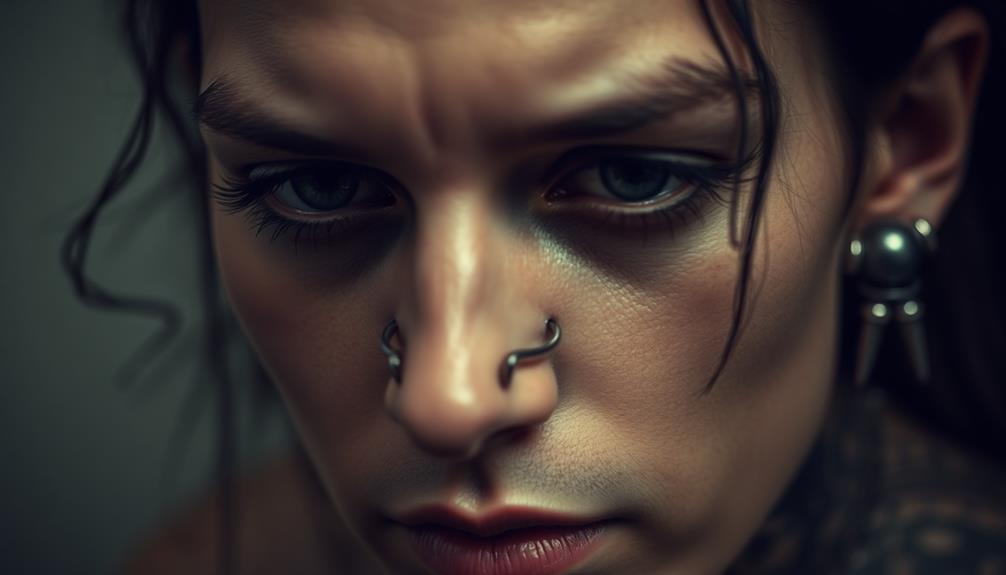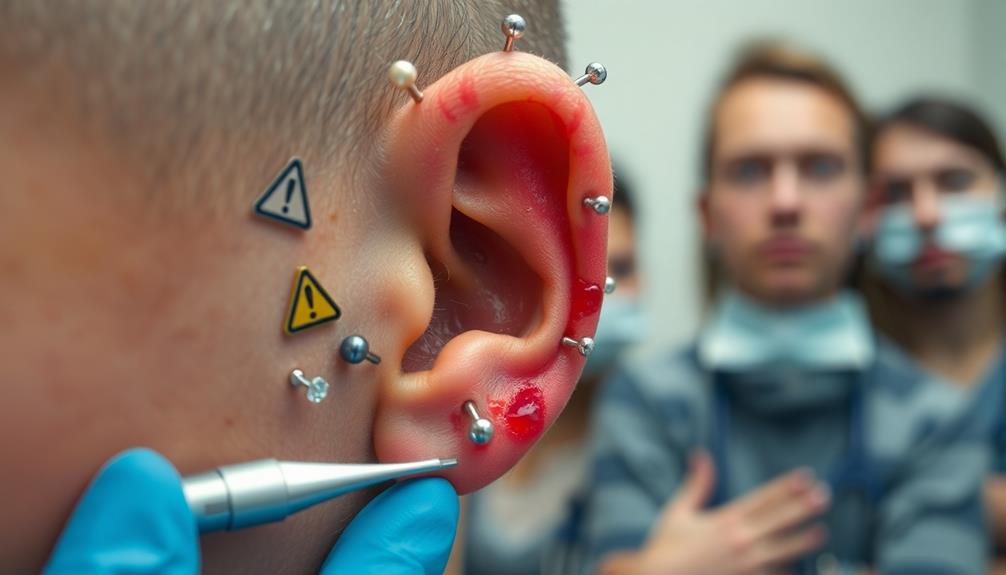Extreme piercings can be a bold expression of your identity, but they also come with risks. You need to be aware of potential health issues like infections and scarring, which can occur without proper care and professional help. Society's mixed feelings about extreme body modifications can lead to stigma, especially in professional environments where visible piercings might not be accepted. While many find empowerment through these modifications, you could face significant challenges if you're not prepared. Exploring the motivations and cultural perspectives surrounding extreme piercings can offer deeper insights into why people choose this path.
Key Takeaways
- Extreme piercings challenge traditional body modifications, requiring careful planning and expertise for safe healing and aesthetic appeal.
- Health risks include infections, scarring, and nerve damage, emphasizing the need for professional piercers and sterile equipment.
- Personal motivations for extreme piercings often stem from self-expression, cultural influences, and psychological factors like body dysmorphia.
- Societal reactions vary from curiosity to stigma, particularly in professional contexts where visible modifications may face discrimination.
- Social media fosters communities that enhance acceptance and visibility of extreme piercings, challenging societal norms around body modification.
Understanding Extreme Piercings

Extreme piercings represent a bold form of self-expression that pushes the boundaries of traditional body modifications. When you explore extreme piercings, you'll discover they often involve large gauge piercings, dermal anchors, and placements in unconventional areas of the body.
This level of modification requires careful planning and technical expertise, as the right piercing jewelry plays a significant role in healing and aesthetics.
While many embrace this form of self-expression for personal or cultural reasons, it's important to recognize the health risks involved. Improper aftercare or unsterilized equipment can lead to infections, scarring, and other complications.
You might also face societal reactions ranging from curiosity to stigma; judgment or discrimination could arise based on your choices.
Understanding extreme piercings means acknowledging the fine line between artistic expression and potential health concerns. It's crucial to prioritize safety while exploring your individuality.
Ultimately, whether you're considering extreme modifications or simply curious, being informed can empower you to make choices that resonate with your identity while protecting your well-being.
Always confirm your piercing experience is backed by professionalism and care—your body's health is paramount. Rights Reserved.
Personal Motivations for Modification

When you choose extreme piercings, you're often expressing your unique identity in a way that feels authentic to you.
This journey can lead to personal growth, as each modification becomes a step toward embracing who you truly are.
Understanding your motivations can deepen your connection to your body and your sense of self.
Individual Identity Expression
Many people turn to extreme piercings as a powerful way to express their individuality and shape their identity. For you, these modifications can reflect personal beliefs, experiences, or artistic desires. By choosing unique piercings, you differentiate yourself from societal norms, creating a more personalized sense of self.
Cultural influences also play a role; tribal practices and rituals can guide your decisions about body modifications. Additionally, psychological factors like body dysmorphia or the search for self-acceptance may motivate you to explore extreme modifications as a way to affirm your identity.
Here's a quick overview of common motivations for extreme piercings:
| Motivation Type | Description |
|---|---|
| Self-Expression | Reflecting personal beliefs or artistic desires |
| Individuality | Differentiating from societal norms |
| Cultural Influence | Impact of tribal practices and rituals |
| Psychological Factors | Addressing body dysmorphia or seeking acceptance |
| Empowerment | Finding joy and satisfaction in personal transformation |
Through these motivations, extreme piercings can be an empowering journey, allowing you to embrace and celebrate your unique identity.
Personal Growth Journey
Embracing body modification often sparks a transformative personal growth journey, where each piercing becomes a step towards greater self-discovery. You might find that your motivations stem from a deep desire for individuality and self-expression, as you seek to differentiate yourself from societal norms.
As you navigate through this process, you develop a stronger sense of self, learning more about your identity with each decision you make.
Many who immerse themselves in extreme modifications report feelings of empowerment and fulfillment, viewing their body art as a reflection of their unique experiences and passions. This journey often involves confronting psychological factors, such as body dysmorphia or the quest for self-acceptance.
For some, these modifications serve as a way to explore and affirm their identity, giving them the courage to embrace who they truly are.
Over time, your approach to body modification may evolve. You might start with smaller changes, gradually progressing to more significant alterations as you become more comfortable in your skin.
Each modification not only enhances your appearance but also marks crucial milestones in your ongoing journey of personal growth.
Cultural Perspectives on Body Art

Body art, from tribal tattoos to elaborate piercings, serves as a powerful expression of identity across various cultures. While tribal practices often celebrate body modifications as rites of passage, mainstream society tends to stigmatize extreme alterations. This contrast highlights how cultural perceptions shape your understanding of body art.
The acceptance of body modifications varies considerably. Some cultures view extreme modifications as sacred traditions, while others label them as excessive. As body art gains popularity, you might notice a shift toward acceptance of moderate alterations like tattoos and piercings, though extreme modifications still face scrutiny.
Cultural narratives and media play a vital role in shaping these perceptions. It's important to recognize how these influences affect your choices and the way you view others' body art.
| Cultural Perspective | View on Body Modifications |
|---|---|
| Traditional Cultures | Sacred and meaningful |
| Modern Western Society | Mixed acceptance, often stigmatized |
| Rising Acceptance | Growing appreciation for self-expression |
Understanding these cultural perspectives can deepen your appreciation for the diverse meanings behind body art.
Health Risks and Safety Concerns

When considering extreme piercings, it's crucial to be aware of the potential health risks and safety concerns that come with them. These modifications can lead to infections, allergic reactions, and scarring, particularly if you don't follow proper hygiene and aftercare protocols.
The American Academy of Dermatology stresses the importance of using sterile equipment and professional piercers to minimize complications.
If you have multiple piercings, your risk of developing keloids—raised scars at the site of an injury—increases. Additionally, nerve damage is a serious concern, especially in areas rich in nerve endings, which can result in prolonged pain or heightened sensitivity.
Moreover, the risk of bloodborne infections, like hepatitis or HIV, spikes if piercings are done in non-sterile environments or by untrained individuals. This highlights the critical need for professional oversight when considering extreme body modifications.
Always prioritize your safety and health by choosing reputable professionals and adhering to aftercare instructions. By doing so, you can greatly reduce the potential health risks associated with extreme piercings.
The Role of Social Media

Social media's impact on extreme piercings is undeniable, as it shapes trends and fosters communities where you can find support and inspiration.
Platforms like Instagram and TikTok allow you to connect with others who share your passion for body modification, making it easier to explore new ideas. Engaging with these communities can also offer insights into innovative marketing strategies that can enhance your personal brand.
However, it's important to stay aware of the potential pitfalls, like unrealistic beauty standards that can influence your choices.
Influence on Trends
Through the lens of social media, extreme piercings have gained unprecedented visibility and popularity. Platforms like Instagram and TikTok allow you to showcase your body modifications, inspiring others to embrace their unique styles. The hashtag #bodymodification has racked up millions of views, proving that acceptance of extreme piercings as a form of self-expression is on the rise.
This phenomenon parallels the emotionally manipulative dynamics often seen in narcissistic relationships, where individuals seek validation through their appearance.
Social media influencers and body artists play a pivotal role in this trend. They share tutorials and personal experiences, which lend legitimacy to those considering similar modifications. As these styles gain traction, piercing studios adapt their offerings to meet the evolving demands of consumers.
Consider these key influences of social media on piercing trends:
- Increased visibility: Extreme piercings are now more accessible and relatable.
- Community building: Online platforms create a sense of belonging among enthusiasts.
- Challenging beauty standards: Discussions around individuality flourish alongside extreme piercings.
- Viral trends: Specific styles gain popularity, driving demand for new piercing options.
Ultimately, social media has transformed extreme piercings from niche modifications into a celebrated form of personal identity.
Community and Support
For those passionate about extreme piercings, online platforms create vibrant communities where individuals can connect, share their journeys, and offer support.
Social media is a powerful tool, allowing you to discover like-minded enthusiasts through hashtags like #ExtremePiercing and #BodyArt. These tags not only help you find content that resonates with your interests but also foster a sense of belonging among individuals who share your passion.
Online forums and groups serve as invaluable resources, offering advice on aftercare, safety, and recommendations for reputable practitioners. When you have questions or concerns about your modifications, you can turn to these communities for guidance and reassurance.
The visual nature of social media allows you to showcase your piercings, promoting self-expression and normalizing diverse body aesthetics that might be overlooked in mainstream culture.
Influencers and body modification artists on these platforms play a significant role in shaping perceptions and trends, helping to enhance the acceptance of extreme piercings.
Societal Reactions and Stigma

Extreme piercings often spark intense reactions, leading to stigma and discrimination that can affect various aspects of life, particularly in professional settings. You might find that employers hold biases against individuals with visible body modifications, impacting your chances in hiring practices. This prejudice can make it challenging for you to secure a position, even if your skills and qualifications are exceptional.
In social settings, public curiosity can turn into judgment, resulting in uncomfortable experiences. You may feel the weight of stares or hear open criticism directed your way. It's disheartening when cultural norms dictate acceptance of traditional modifications while ignoring your personal choices.
Consider these points:
- Traditional practices are often accepted, while individual modifications face scrutiny.
- Biases can hinder employment opportunities and career advancement.
- Uncomfortable social interactions may arise from public judgment.
- A cultural double standard exists in how body art is interpreted.
Despite the growing acceptance of more mainstream body modifications, extreme piercings still carry a significant stigma. Traversing this landscape can be tough, but understanding societal reactions can empower you to confront these challenges head-on.
The Future of Body Modification

The future of body modification looks promising as society gradually embraces diverse forms of self-expression, including extreme piercings. As cultural perceptions continue to shift, you'll likely notice increased acceptance driven by the visibility of body art in media and social platforms.
The rise of these platforms has allowed individuals like you to share personal experiences, fostering communities around alternative forms of self-expression.
Emerging trends may also bring technological advancements, such as digital implants and biocompatible materials, enhancing safety and broadening creative possibilities for modifications. This evolution will likely encourage you to explore innovative approaches to body art that were previously unimaginable.
However, ongoing dialogue about the boundaries of body modification remains essential. As conversations surrounding consent, health risks, and personal expression gain traction, you'll find that society is beginning to recognize body modifications as legitimate forms of self-expression.
This shift could challenge existing double standards, particularly when comparing extreme piercings to traditional cosmetic procedures, paving the way for new societal norms that celebrate individuality.
Ultimately, as acceptance grows, the future of body modification appears bright, inviting you to express your identity authentically.
Frequently Asked Questions
Do Piercings Count as Body Modifications?
Yes, piercings definitely count as body modifications. They intentionally alter your body's appearance, allowing you to express your identity and personal style. Each piercing you choose reflects a part of who you are.
What Is Considered Extreme Body Modification?
Extreme body modification includes practices like extensive scarification, branding, subcutaneous implants, and large-scale piercings that greatly alter your appearance. These modifications often challenge societal norms and may provoke strong reactions from those around you.
What Are Considered Extreme Piercings?
Did you know that approximately 15% of Americans have body piercings beyond traditional earlobes? Extreme piercings include large gauges, corset piercings, and surface piercings, often pushing boundaries of personal expression and cultural acceptance.
Why Are People Against Body Modification?
Many people oppose body modification due to health risks, societal stigma, and concerns about mental health. They often worry about infections, complications, and the potential for underlying psychological issues, leading to strong negative perceptions.
Conclusion
In a world where body modification is becoming more mainstream, it's essential to understand the fine line between self-expression and extreme alterations. Did you know that around 20% of adults in the U.S. have some form of body modification? This statistic highlights how prevalent these practices are, yet also emphasizes the need for awareness regarding health risks and societal perceptions. Ultimately, it's about finding a balance that respects both personal identity and well-being.
Hi, my name is Danielle, and I’m an author for piercings-body.com. I have a passion for writing and love to share my knowledge on all things body piercing-related. I’m also a huge advocate for safe body modification practices and believe everyone should be able to make informed decisions about their bodies. When I’m not writing or blogging, I enjoy spending time with my family and friends, practicing yoga, and exploring new places.
















